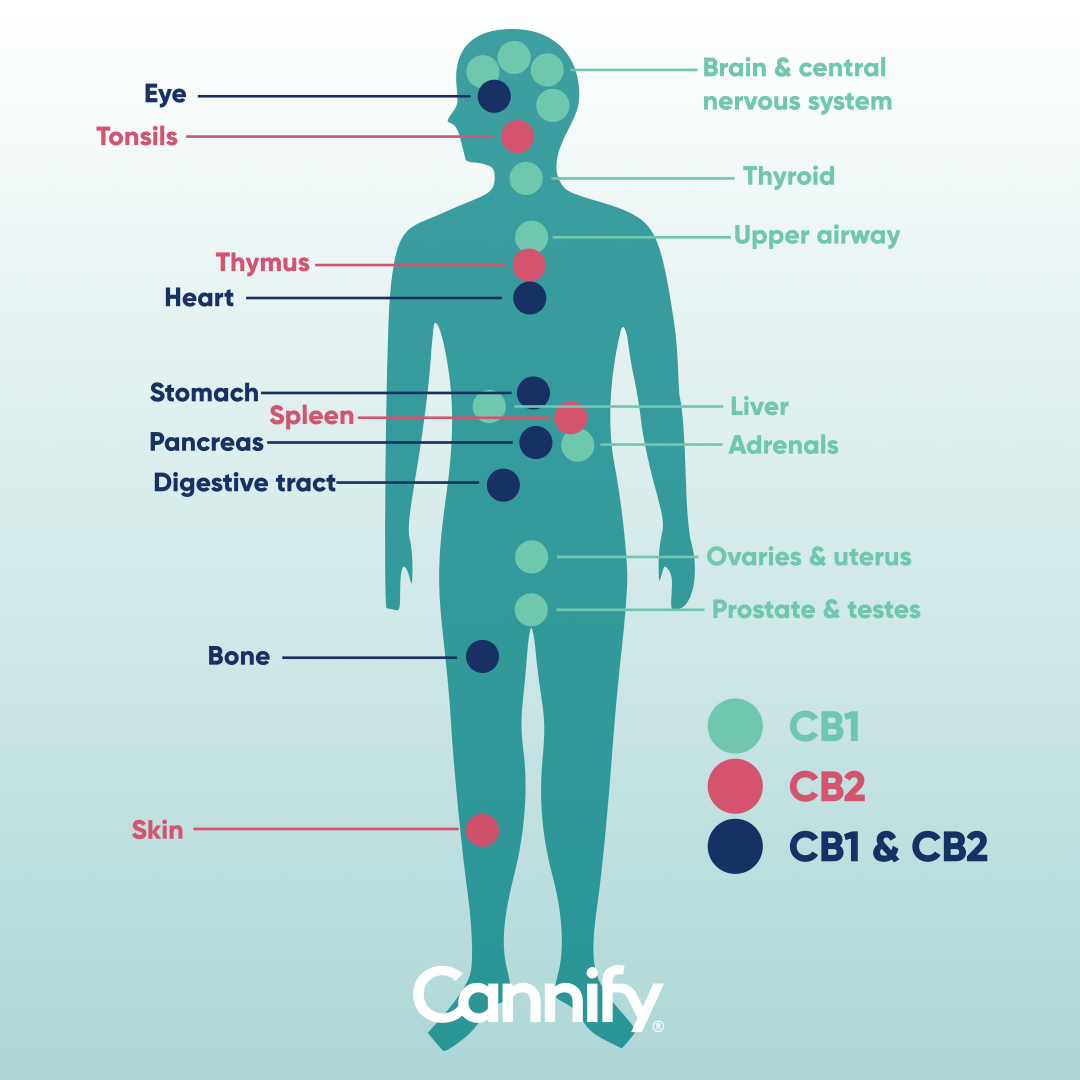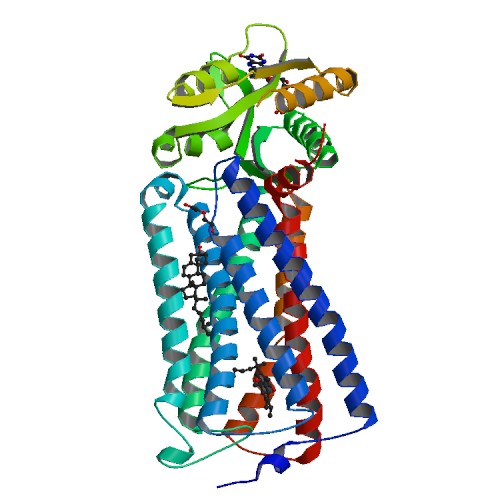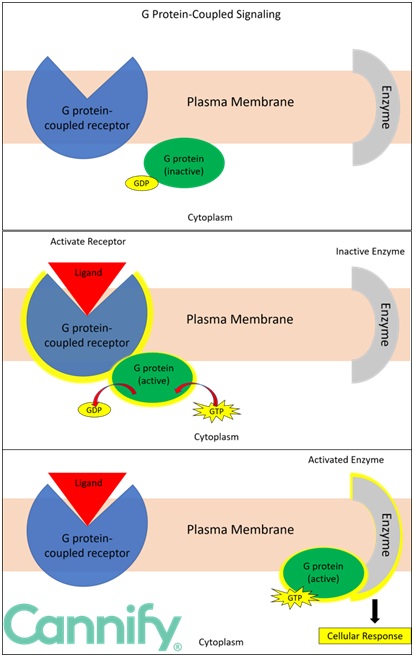Receptors
Receptors are binding places in the body that receive chemical signals leading to different effects. There are various types of receptors and the cannabinoid receptors belong to a large family of the so-called G-protein coupled receptors (GPCRs, see Figure 2). So far, two types of cannabinoid receptors have been identified and cloned,
1, 2 while there are speculations about additional types.
3
 Figure 1: A simplified representation of the location of CB receptors in the body (image recreated based on Reddy et al., 2019).
Figure 1: A simplified representation of the location of CB receptors in the body (image recreated based on Reddy et al., 2019).
The
cannabinoid receptor type 1 (CB1), illustrated in Figure 2, is predominantly present in the central nervous system (brain and spinal cord), particularly in those brain regions which regulate functions that typically become disturbed when under the influence of cannabis: sleep, appetite, perception of time, short-term memory, coordination, etc.
4 In fact, CB
1 is the most abundant GPCR known to be present in the brain.
5
 Figure 2: Crystal structure of the human CB1 in complex with agonist AM841 (image taken from IUPHAR/BPS).
Figure 2: Crystal structure of the human CB1 in complex with agonist AM841 (image taken from IUPHAR/BPS).
The
cannabinoid receptor type 2 CB2 looks similar to CB
1 and is mainly present on cells of the immune system where it can influence pain, inflammation and tissue damage.
6
It should be noted that not all cannabinoid effects can be explained by receptor-binding alone, and it is believed that at least some effects are caused by other mechanisms.
7, 8
 Figure 3: G protein-coupled signaling is a mechanism in which a ligand, in our example a drug, binds to the G protein-coupled receptor and causes another protein to activate and elicit a cellular response, in this case, an enzyme. The signaling takes place in a series of steps: 1) the ligand (drug) binds to the G protein-coupled receptor, 2) the G protein-coupled receptor changes its shape, 3) the G protein then exchanges guanosine diphosphate (GDP) for guanosine triphosphate (GTP), and finally 4) the G protein then migrates to a protein (enzyme or ion channels) where it regulates (activates) the protein causing a response.
Figure 3: G protein-coupled signaling is a mechanism in which a ligand, in our example a drug, binds to the G protein-coupled receptor and causes another protein to activate and elicit a cellular response, in this case, an enzyme. The signaling takes place in a series of steps: 1) the ligand (drug) binds to the G protein-coupled receptor, 2) the G protein-coupled receptor changes its shape, 3) the G protein then exchanges guanosine diphosphate (GDP) for guanosine triphosphate (GTP), and finally 4) the G protein then migrates to a protein (enzyme or ion channels) where it regulates (activates) the protein causing a response.
Watch a brief summary video about CB
1 and CB
2 made in collaboration with
Enlighten on
YouTube or on
the screens page.
- Matsuda, Lisa A.; Lolait, Stephen J.; Brownstein, Michael J.; Young, Alice C.; Bonner, Tom I. (1990). Structure of a cannabinoid receptor and functional expression of the cloned cDNA. Nature, 346(6284), 561--564.
- Munro, Sean; Thomas, Kerrie L.; Abu-Shaar, Muna (1993). Molecular characterization of a peripheral receptor for cannabinoids. Nature, 365(6441), 61--65.
- Fonseca, B. M.; Teixeira, N. A.; Almada, M.; Taylor, A. H.; Konje, J. C.; Correia-da-Silva, G. (2011). Modulation of the novel cannabinoid receptor - GPR55 - during rat fetoplacental development. Placenta, 32(6), 462--469.
- Fattore, Liana; Melis, Miriam; Fadda, Paola; Pistis, Marco; Fratta, Walter (2010). The endocannabinoid system and nondrug rewarding behaviours. Experimental neurology, 224(1), 23--36.
- Nogueras-Ortiz, Carlos; Yudowski, Guillermo A. (2016). The Multiple Waves of Cannabinoid 1 Receptor Signaling. Molecular Pharmacology, 90(5), 620--626.
- Szabo, Gergely G.; Lenkey, Nora; Holderith, Noemi; Andrasi, Tibor; Nusser, Zoltan; Hajos, Norbert (2014). Presynaptic Calcium Channel Inhibition Underlies CB1 Cannabinoid Receptor-Mediated Suppression of GABA Release. Journal of Neuroscience, 34(23), 7958--7963.
- Mallipeddi, Srikrishnan; Janero, David R.; Zvonok, Nikolai; Makriyannis, Alexandros (2017). Functional selectivity at G-protein coupled receptors: Advancing cannabinoid receptors as drug targets. Biochemical Pharmacology, 128, 1--11.
- Pertwee, Roger G. (2014). Handbook of Cannabis. Handbooks in Psychopharmacology, 44(8), 085201.
 Figure 1: A simplified representation of the location of CB receptors in the body (image recreated based on Reddy et al., 2019).
The cannabinoid receptor type 1 (CB1), illustrated in Figure 2, is predominantly present in the central nervous system (brain and spinal cord), particularly in those brain regions which regulate functions that typically become disturbed when under the influence of cannabis: sleep, appetite, perception of time, short-term memory, coordination, etc.4 In fact, CB1 is the most abundant GPCR known to be present in the brain.5
Figure 1: A simplified representation of the location of CB receptors in the body (image recreated based on Reddy et al., 2019).
The cannabinoid receptor type 1 (CB1), illustrated in Figure 2, is predominantly present in the central nervous system (brain and spinal cord), particularly in those brain regions which regulate functions that typically become disturbed when under the influence of cannabis: sleep, appetite, perception of time, short-term memory, coordination, etc.4 In fact, CB1 is the most abundant GPCR known to be present in the brain.5
 Figure 2: Crystal structure of the human CB1 in complex with agonist AM841 (image taken from IUPHAR/BPS).
The cannabinoid receptor type 2 CB2 looks similar to CB1 and is mainly present on cells of the immune system where it can influence pain, inflammation and tissue damage.6
It should be noted that not all cannabinoid effects can be explained by receptor-binding alone, and it is believed that at least some effects are caused by other mechanisms.7, 8
Figure 2: Crystal structure of the human CB1 in complex with agonist AM841 (image taken from IUPHAR/BPS).
The cannabinoid receptor type 2 CB2 looks similar to CB1 and is mainly present on cells of the immune system where it can influence pain, inflammation and tissue damage.6
It should be noted that not all cannabinoid effects can be explained by receptor-binding alone, and it is believed that at least some effects are caused by other mechanisms.7, 8
 Figure 3: G protein-coupled signaling is a mechanism in which a ligand, in our example a drug, binds to the G protein-coupled receptor and causes another protein to activate and elicit a cellular response, in this case, an enzyme. The signaling takes place in a series of steps: 1) the ligand (drug) binds to the G protein-coupled receptor, 2) the G protein-coupled receptor changes its shape, 3) the G protein then exchanges guanosine diphosphate (GDP) for guanosine triphosphate (GTP), and finally 4) the G protein then migrates to a protein (enzyme or ion channels) where it regulates (activates) the protein causing a response.
Watch a brief summary video about CB1 and CB2 made in collaboration with Enlighten on YouTube or on the screens page.
References:
Figure 3: G protein-coupled signaling is a mechanism in which a ligand, in our example a drug, binds to the G protein-coupled receptor and causes another protein to activate and elicit a cellular response, in this case, an enzyme. The signaling takes place in a series of steps: 1) the ligand (drug) binds to the G protein-coupled receptor, 2) the G protein-coupled receptor changes its shape, 3) the G protein then exchanges guanosine diphosphate (GDP) for guanosine triphosphate (GTP), and finally 4) the G protein then migrates to a protein (enzyme or ion channels) where it regulates (activates) the protein causing a response.
Watch a brief summary video about CB1 and CB2 made in collaboration with Enlighten on YouTube or on the screens page.
References:_logo.svg)